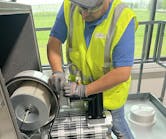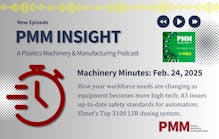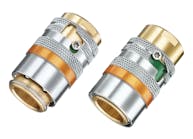Have you found an innovative equipment solution to a plastics processing challenge? Let us know.
Problem: A custom molding shop needed a cost-effective way to automate a potentially dangerous job.
Solution: A company that provides Robotics-as-a-Service supplied a robot at a rate below minimum wage.
By Karen Hanna
One startup’s efforts to democratize access to automation have brought relief to employees of a Phoenix molding shop, which in the midst of a labor shortage was grappling with the best way to unload hot, heavy parts from a press.
Family-owned Icon Injection Molding’s application is typical of the kinds of cases three-year-old Formic has addressed with its emerging approach to pricing — subscription packages, or Robotics-as-a-Service (RaaS), according to Misa Ilkhechi, VP of products and partnerships for Formic.
“Buying automation is an extensive process of finding the right solution ... and maintaining it. I think it’s a big investment, capital-wise and time-wise, for a lot of manufacturers, which they can’t spare; they’re playing this game of Whac-A-Mole, making sure that the product is coming through the door,” he said.
Icon’s growth has been “explosive,” said Nicole Kleitsch-Killam, the chief administrative officer of the 22-year-old custom molding shop, and daughter and niece of its founders. Filling positions can be challenging, especially for overnight and weekend shifts.
But those problems weren’t the only reason she started looking into automation with capabilities beyond the company’s sprue robots and basic robots to supplement its workforce of 100 or so employees.
A contract for parts for drilling equipment has been ramping up over the past couple years. Called gliders, the parts are made up of a proprietary blend of glass-filled nylon and come in two versions, weighing between about 5 and 8 pounds.
A 720-ton IMM, running two different molds, produces the parts.
“The two main factors that led us to automating were, one, the danger of the activity. It’s a very heavy part, it’s about 5 pounds, and it gets very hot,” she said. “... And the other issue was ... just the difficulty in finding workers.”
As a member of the company’s safety committee, Kleitsch-Killam explored ways to automate the process, knowing that workers alone wouldn’t be able to keep up with demand.
She said Icon’s customer indicated “if we were able to get creative and work with him and come up with a solution, there would be more work.”
The first company Icon approached was a traditional automation integrator. But that route proved untenable.
“Working in the industry and talking to companies, it does come down to budget at the end of the day. When you’re making parts for pennies, and your customers are beating me up about a 10th of a cent. …" she said. “Budget is really important to us, and efficiency is important.”
Then, Icon negotiated with Formic.
The proposal was eye-opening, Kleitsch-Killam said.
“We talked in the C-suite. The rest of them explained it to me and I’m like, ‘Guys, this sounds too good to be true,’ ” Kleitsch-Killam said.
According to Formic’s website, RaaS contracts — which require a minimum usage term — typically run one to five years. Depending on the length of the contract, a Formic customer might pay $8 to $40 an hour for each hour its robot actually runs.
Icon sprang for a six-axis articulated Fanuc robot that costs just $10 an hour — almost $4 an hour less than Arizona’s minimum wage of $13.85.
Formic can retrofit robots to older IMMs, Kleitsch-Killam said, and it supplies all necessary accessories to set up the systems.
For Icon, that meant adding a splash guard to prevent water from spilling as a vertical conveyor transfers the gliders from the robot to a water bath at rates workers weren’t able to attain.
According to Ilkhechi, Formic clients only pay for usage when robots meet pre-determined cycle-time goals. The company programs, monitors, maintains and upgrades all automation it supplies.
“First of all, we don’t bill for the hours that our robot is down, and second of all, we go and fix that at no additional cost to our end users. However, we monitor these machines remotely, so the chance of a machine going down is almost slim to none,” he said.
The packaging and pricing scheme reflect the mission Ilkhechi and partner Saman Farid set out to achieve when they co-founded Formic — to provide automation that manufacturers could employ without requiring a big investment or on-staff expertise.
“Because we buy machines at scale, usually our costs to buy those machines is lower than what you would pay in the open market ... not only on the hardware, but also on the spare parts and everything else that we need to keep that machine up and running,” Ilkhechi said.
The LinkedIn profile for company CEO Farid summarizes the goal: “Supplying the world with a robot workforce.”
The six-axis and gantry robots Formic offers from Wittmann, Fanuc and Yaskawa Motoman can perform takeout, gating, deburring, stacking, palletizing and other tasks, Ilkhechi said.
About 80 percent of Formic’s customers are deploying automation for the first time, Ilkhechi said; he estimated about 70 percent of the customers wouldn’t be able to do so under conventional pricing models.
“We want it to turn the game on its head a little bit and shift the risk from the manufacturer to somebody who understands the technology better and can stand behind it,” he said.
Molders are among the biggest sources of demand for Formic’s services — a phenomenon Ilkhechi said “wasn’t something that was initially on our radar.”
But, in addition to the labor shortage, reshoring has burnished automation’s appeal. “And now with all the supply chain challenges that we faced the past couple of years, people are thinking about bringing more products to be manufactured here,” he said.
Like Icon, most of Formic’s customers are small and mid-size companies that either can’t muster large capital expenses for automation or don’t have the staff to spec out, program and maintain the technologies, he said.
Kleitsch-Killam said doing business with Formic echoes the way Icon approaches business with its own customers.
“What we try to give to our customers is that, ‘We’re going to work with you through every step of this and figure that out,’ and we really got that from Formic,” she said.
About a month into watching the new Fanuc perform on all cylinders, Kleitsch-Killam predicted in July that her company will continue to turn to Formic.
“We were just really blown away by the way that they do business and their pricing,” she said.
According to Formic's website, over their careers, Formic team members have deployed 5,000 robots. Formic's robots have performed 32,000 hours of automated tasks.
But, according to Ilkhechi, it’s just getting started.
“I am very happy with the results that we have been able to provide to our customers and the growth we’re seeing,” he said. “But it’s a deep blue ocean.”
Karen Hanna, senior staff reporter
Contact:
Formic Technologies Inc., Chicago, 844-436-7642, www.formic.co
Karen Hanna | Senior Staff Reporter
Senior Staff Reporter Karen Hanna covers injection molding, molds and tooling, processors, workforce and other topics, and writes features including In Other Words and Problem Solved for Plastics Machinery & Manufacturing, Plastics Recycling and The Journal of Blow Molding. She has more than 15 years of experience in daily and magazine journalism.






